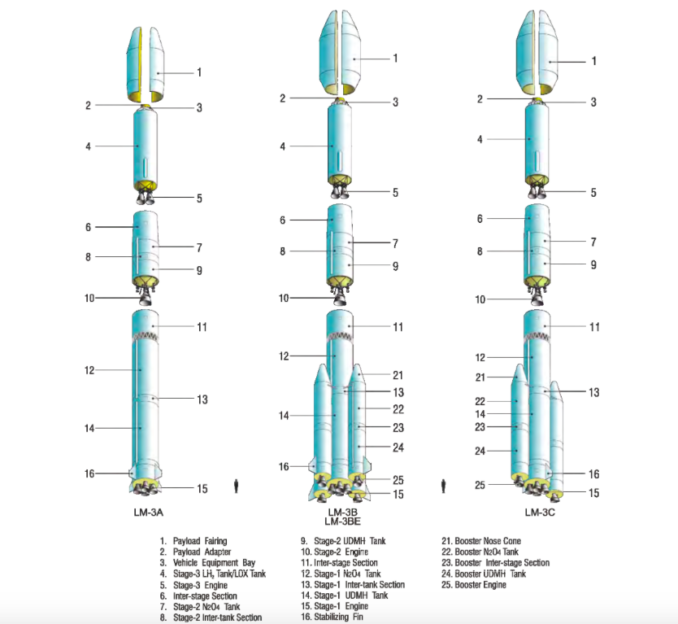Launch Window/Lift Off Time | December 06, 2020 – 03:49-04:17 UTC | 11:49-12:17 BJT |
|---|---|
Mission Name | Gaofen 14, an Earth observation satellite |
Launch Provider | China Great Wall Industry Corporation (CGWIC) |
Customer | China Association for Science and Technology (CAST) |
Rocket | Long March 3B/E |
Launch Location | Xichang Satellite Launch Center, China |
Payload mass | Unknown, up to 7,100 kg (15,700 lb) to Sun-synchronous orbit |
Where is the satellite going? | Probably Sun-synchronous orbit |
Will they be attempting to recover the first stage? | No. The boosters of the rocket are not recoverable. |
Where will the first stage land? | It will crash back over land in North-West China |
Will they be attempting to recover the fairings? | No. The fairings are not recoverable. |
Are these fairings new? | Yes |
How’s the weather looking? | No information available |
This will be the: | – 72nd flight of a Long March 3B (any variant) – 12th launch of a Gaofen satellite in 2020 (the numbering is strange) – 35th launch from China in 2020 – 8th launch of a Long March 3B/E variant in 2020 – 8th launch of a Long March 3B in 2020 (all have been the E variant) |
Where to watch | Official livestream (if available) |
What’s all this mean?
China is launching Gaofen 14, a civilian Earth observation satellite, on December 6, at around 03:55 UTC. It will launch on top of a Long March 3B/E rocket. Gaofen 14 is the latest in the series of remote sensing satellites for China. The launch is going to Sun-synchronous orbit (probably).
Gaofen Satellites
The Gaofen satellites form a series of civilian Earth observation satellites. They are part of China’s High-definition Earth Observation System (CHEOPS). This is a government-funded program designed to provide real-time global surveillance data. The system is composed of satellites, conventional airborne system, and airships in the stratosphere.
Gaofen 14
We have very few details on the Gaofen 14 satellite. If we look at information on the previous Gaofen 13 mission, we may gain some insight into it. Gaofen 13, which launched as recently as October 12, 2020, is an optical remote sensing satellite. It is mainly used in land surveying, estimation of crop yields, weather forecasting and other environmental tasks.
Gaofen 13 however was launched into Geostationary Earth Orbit (GEO), whereas we understand that Gaofen 14 is going to Sun-synchronous orbit. We can predict this based on the “no-fly zone” notices that have been issued in advance.
What is the Long March 3B?
Most of China’s orbital launch vehicles are called “Long March” (Chinese: Chang Zheng). This is despite their heritage being different from each other. The Long March 3B was first launched in 1996. It is a three stage rocket (with optional fourth stage), supported by liquid-fueled side-mounted boosters.
The Long March 3B/E (E for Enhanced) was first launched in 2007. It has greater payload mass capability for reaching Geostationary Transfer Orbit (GTO). The first stage is larger than on the regular Long March 3B. Also, the side boosters are larger too. As a result, its payload to GTO has been increased to 5,500 kg (12,100 lb). (Standard LM-3B payload to GTO is 5,100 kg).
The Long March 3B series features the following sections or stages:
- side boosters
- first (center) stage (ignited at launch)
- second stage
- third stage
- optional fourth stage
Side boosters
There are 4 side boosters, each using just one YF-25 engine. The engines are powered by Unsymmetrical Di-Methyl Hydrazine (UDMH) and Nitrogen Tetroxide (N2O4).
Regular Long March 3B side boosters are 15.33 m (50.3 ft) long, but on the 3B/E they are 16.1 m (52.3 ft) long. The provide 740 kN of thrust each. The YF-25 engine has a specific impulse (ISP) of 260 seconds. This measure of efficiency should not be confused with the burn time however. The regular LM-3B side boosters burn for 127 seconds. The 3B/E variant burns for 140 seconds.
First (center) stage
The first stage has 4 YF-21C engines, also using UDMH / N2O4 for propellant. In fact, most Long March rockets of all models use this form of propellent. The Long March 5 is a recent deviation from this pattern.
The regular LM-3B first stage is 23.27 m (76.35 ft) tall, but the 3B/E is 24.76 m (81.23 ft) high. The combined thrust of all four engines is 2,960 kN. The specific impulse of these engines is 260 seconds. They burn for 158 seconds before staging.

Second Stage
The second stage is once again powered by UDMH and N2O4. It is 12.9 m (42.3 ft) tall. Its thrust is provided by a single fixed YF-22E engine. Guidance is provided by a single YF-23 vernier engine. Combined, these engines are known as a YF-24 module.
The thrust of this stage is 742 kN. The burn time is 185 seconds.

Third stage
The third stage is almost the same size as the second stage! It is 12.4 m (40.7 ft) long. It is powered by 2 YF-75 engines. This stage is powered by liquid hydrogen (LH2) and liquid oxygen (LOX).
The third stage will typically burn after the second stage is jettisoned, in order to continue to raise the orbital apogee (maximum altitude). Once the apogee (more generally, apoapsis) has been achieved, it shuts down. The vehicle will then typically coast up to its apogee using momentum alone. At apogee, the stage relights and burns facing forwards in order to raise the perigee (lowest altitude) of the orbit. Without performing this second burn, the spacecraft would not stay in space and would reenter the atmosphere and be destroyed by heating.
Optional fourth stage
If used, the fourth stage is powered by a single YF-50D engine. This engine runs on the familiar UDMH / N2O4 combination that we have seen before.
We don’t know if the fourth stage is being used on this flight.



